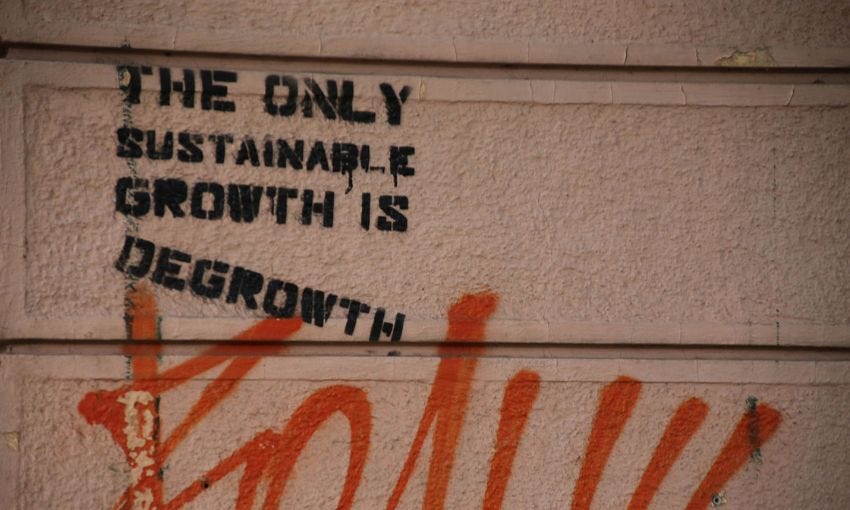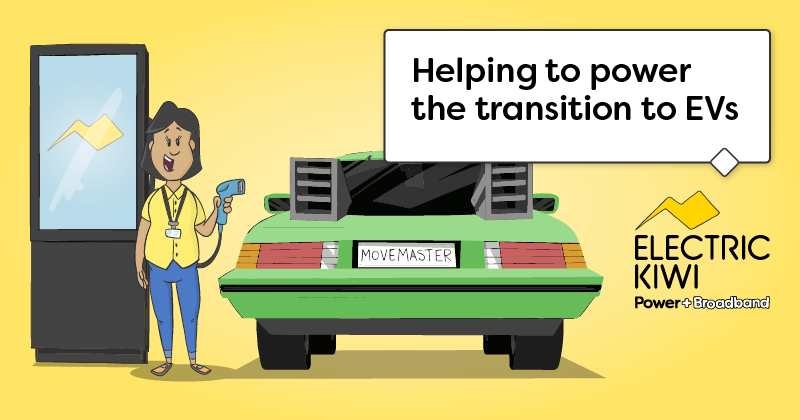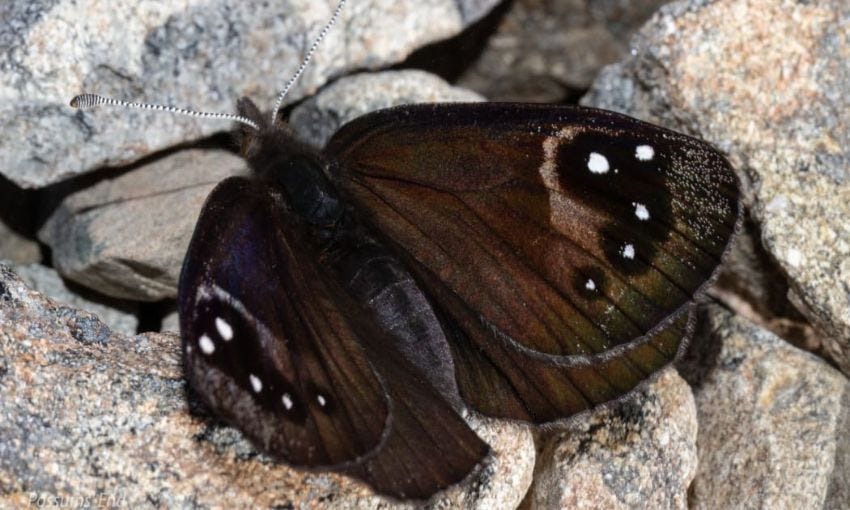What does 'degrowth' actually mean?
“If we’re going to have growth, let’s have some really intelligent growth that doesn’t continue to trash the environment.”
Kia ora, welcome to Future Proof, brought to you by Electric Kiwi.
Image credit: Paul Sableman/Wikimedia (CC BY 2.0).
The idea of ‘de-growing’ the economy might seem incongruous for a brekkie attended by some of New Zealand’s top business directors, but it was the main topic of discussion at last week’s Chapter Zero event hosted by the Institute of Directors. Sustainability experts Sir Jonathon Porritt, Professor Tim Jackson, and Sam Mostyn challenged the room to get climate literate, quick-smart, and start imagining “a better kind of life than the materialistic, capitalistic, selfish self-oriented, growth-obsessed form of society and economy that we live in at the moment”. (Oof. Jackson wasn’t pulling any punches.) But what exactly is degrowth? Is it just the latest corporate-speak buzzword, or can this idea really help us tackle climate change?
What degrowth means (and doesn’t mean)
We assume that growth is good – but on a planet with finite resources, infinite growth is impossible. Climate change is “only one symptom of a much more problematic issue,” said Porritt, “which is a notion of progress and wealth creation that depends pretty much on destroying the planet on which we live.” So what’s the alternative? Maybe, scale back our economic activity and rein in consumption, aka degrowth (which is a bit of a crap name, to be honest). Despite how it sounds, degrowth doesn’t mean austerity. We wouldn’t go back to horses and carts and candles in mud huts. But it does mean consuming (and producing) less stuff, so we lessen our impact on the Earth. It might mean shifting our focus away from GDP as a measure of how well we’re doing, and thinking more about happiness and wellbeing (like Bhutan, which famously measures Gross National Happiness). Jackson frames it as a choice between two stories: “One story is build your economy as fast as possible and people will consume their way to paradise,” he said, “And the second story is: build the life force of sea and land and the people will thrive.”
Is degrowth even achievable?
How would we even achieve such a radical shift? It would be challenging – and some argue that degrowth as a serious policy is quite simply impossible to implement, especially if we want to lift people out of poverty. While degrowth might send shivers down the spine of CEOs, the idea of broadening focus from purely financial returns to include environmental and social dividends is emerging in boardrooms globally. Mandatory climate disclosures are a step towards such climate-literate business leadership. And directors will need to think about climate and nature risks the same way they think about safety risks and liability, according to Mostyn. But New Zealand is lagging behind overseas companies when it comes to environmental and social considerations, I learned earlier this year in an interview with leadership expert Professor Brad Jackson.
Decoupling emissions from growth
We might be on track to decouple emissions from growth, according to climate change Minister James Shaw. He noted that around 20 countries have already begun to shrink their emissions while still increasing their GDP. And he pointed to the case study of Japan, where a declining population and stagnant GDP have persisted for more than 20 years. Yet, happiness surveys indicate people in Japan are happier now than they were 20 years ago. Perhaps that’s a way forward: focusing on growing those good things we’re currently lacking. Shaw said he’d like to see growth in solar panels, wind farms, electric vehicles and public transport. I’d like to see growth in joy, kindness and caring too – for both people and the planet.
Range anxiety, charging station locations and increasing power bills – there’s a lot to think about when transitioning to an electric vehicle.
Electric Kiwi has a grand plan to ease those concerns by partnering with some of the leaders in EV technology, while offering customers a competitive time of use power plan, MoveMaster, to facilitate cheap off-peak charging.
The pieces of the EV transition puzzle exist and are emerging, now it’s about making them fit together so Kiwis can make the switch with confidence.
Click here to find out how they’re making a difference.
Could sustainable whitebait fritters be on the menu?
New Zealand’s first commercial whitebait farm has launched in Bluff this week, Maddy Lloyd reports for 1News. Manāki Whitebait is hoping to produce 50 tonnes of whitebait every year, and they’re aiming for fish to be available from February 2023. This comes after a shortened whitebait fishing season this year, which aimed to reduce fishing pressure on the stocks. Whitebait is the collective name for the juveniles of five species of native galaxiid fish – four of which are at risk of extinction.
Another Cop already?
Yes, it’s another UN ‘Conference of Parties’ aka Cop, and this time it’s a summit focused on biodiversity loss called Cop15. The Guardian has a neat lil explainer, while Carbon Brief has compiled a handy interactive so you can see the different priorities for different countries. For example, New Zealand opposes quantitative values for pesticide phase out, but halting and reversing biodiversity loss by 2030 is a “high priority”. In a comment to the Science Media Centre, law professor Nathan Cooper from the University of Waikato says to expect a focus on 30x30 – the idea of protecting 30% of both land and sea. Meanwhile, last week the UN found that finance for nature needs to double to $384 million every year by 2025 to reach global climate and biodiversity goals.
Earthshot prizewinners announced
The Earthshot prize from the Prince of Wales awards £1 million to five winners developing innovative solutions to environmental problems. Among this year’s awardees are the Indigenous women’s ranger network in Queensland, for their mahi to protect and restore the Great Barrier Reef. One scientist who reviewed the nominees has collated the winners and their inspiring projects on The Conversation.
Renewables will double in next five years
The International Energy Agency predicts that renewables like solar, wind and hydro will overtake coal as the largest source of energy generation in 2025. As we enter an “extraordinary” new phase, the next five years will see the world add as much renewable capacity as it did in the previous 20 years.
The surprising pest in your backyard (and the traps to deal to them)
Chris Schulz, of The Spinoff’s Stocktake newsletter, chats to local pest control company Goodnature about their innovative traps, and discovers that hedgehogs are oft-overlooked predators dealing a heap of damage to our native wildlife. Yes, those snuffling spiky fellas are munching on all our wētā (one was found with 283 wētā legs in its stomach!) and also chow down on our native lizards, eggs and chicks.
More stories:
$350 million announced for transport projects including climate-friendly infrastructure like bus stops, bus lanes and cycleways, Kate Green reports for RNZ.
Fast-growing hemp could be twice as effective as trees at sucking up and storing carbon.
Some people are choosing not to have children because of climate change. But the science underpinning the idea that having kids is bad for the environment is not so clear-cut.
This Manawatū company, Precycle, is taking demolition waste material considered ‘non-recyclable’ and transforming it into construction material.
The EU is adding shipping into its carbon market, making ships pay for their CO2 pollution from 2024, and including their methane and nitrous oxide emissions from 2026. The maritime sector contributes around 3% of the global carbon footprint.
Making simple changes to your laundry routine – like washing on cold – can go a long way in helping you reduce emissions, save money and take better care of your clothes.
We’ve talked a fair bit in Future Proof about the pitfalls of carbon offsets, and I couldn’t go past this hilariously apt comparison in Bloomberg: Are carbon offsets the labradoodle of climate solutions?
Please don’t be like these people: Drivers ignore rules and hoon through endangered bird nesting habitat on crate day. I really have no words for this selfish stupidity.
Image credit: Possums’ End (CC BY 4.0).
To finish this issue, last Friday’s Critter of the Week on RNZ was the pepe pōuri / black mountain ringlet butterfly – a goth beauty perfectly suited to the new Wednesday Addams reboot, which I’ve been enjoying on Netflix. Apparently these alpine-dwelling butterflies can be found up to 2500m above sea level! They can often be seen soaking up the warm sunshine – a pastime I’m very much looking forward to indulging in over summer.
Hope these last few work weeks butter-fly by,
Ellen
Got some feedback about Future Proof or topics you’d like covered? Get in touch with me at futureproof@thespinoff.co.nz














